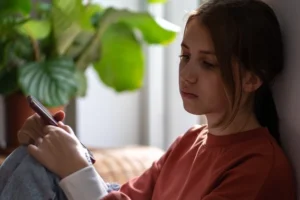Do teens want parental controls?
The findings, released today as part of this year’s Safer Internet Day, reveal 65% of young people aged 11-16 are in favour of parental controls. These settings are available across apps, devices and platforms. 69% think they’re in place to stop them viewing inappropriate adult content.
A third of kids thought they should be at least aged 15 before they go online without any restrictions. However, a quarter of teens (24%) surveyed think that parental controls and restrictions should only be taken away once they are over the age of 17 years.
The survey of kids found:
- Over two thirds (66%) of young people think parental controls are used to stop them being contacted by strangers.
- More than a third of teens (33%) think they should be able to go online aged 15-16 without any parental controls.
How many parents use parental controls?
Additional research found that, despite the vast majority of parents being aware of controls, only 4 in 10 parents use them.
A survey of parents with kids aged 4-16 found that only 39% of parents set controls across their broadband or mobile network. Additionally, just 35% of parents set controls on devices their children use at home with only 45% applying privacy settings to their child’s social media.
The survey of parents found:
- 1 in 5 parents (19%) admit they don’t set parental controls as they are ‘too restrictive’
- 1 in 10 parents (11%) admit they don’t set parental controls as ‘they’re too complicated’
- 17% of parents say there’s ‘no point as children can get round them’
- 13% claim it restricts their internet usage
What are Set Up Safe guides?
The research was carried out ahead of the launch of our new step-by-step parental controls and privacy guides to make it easier for parents to get their child’s device ‘Set Up Safe’. With a more than 70 guides, they cover a broad range of devices, networks, platforms and apps.
The Set Up Safe guides provide information and simple step-by-step instructions to set content filters and privacy settings on a range of devices, networks and platforms.
And for those parents who need more hands-on help, Internet Matters’ newest and first mobile partner EE will be opening up their doors to all parents across all their UK stores. They will be offering support to those who are struggling to get to grips with practicalities of parental controls and device settings, with simple hands-on advice.
Why are parental controls important?
Internet Matters CEO, Carolyn Bunting MBE:
“Technology can seem overwhelming and research has shown this is often the reason parents don’t apply parental controls.
“But setting age-appropriate controls can help protect children from potential risks online.
“Our new Set Up Safe guides are designed to show parents how to set parental controls, for a whole range of the most popular apps and devices, in a really clear and easy to follow way.
“As ever, it’s important parents remember this is just one of the tools in the online safety toolkit and parents need to ensure they are having regular, frank and open conversations with their child about their digital world to ensure they are staying safe online.“
Marc Allera, CEO of BT’s consumer brands EE, BT and Plusnet:
“We all know it can be tough for parents to stay on top of the latest apps, games and social networks that their children are using.
“As a parent, I know how important it is to address online safety with our children, and our partnership with Internet Matters means we can help provide practical advice to parents about online behaviour, safety and security. “We have also introduced new training for our staff in stores and contact centres to provide
better support for online safety topics to even more parents across the UK.”
Internet Matters Ambassador and psychologist, Dr Linda Papadopoulos:
“It’s essential parents set-up age-appropriate parental controls on their child’s device to ensure they have a safe place to be online.
“Building online boundaries should be no different to any other life stage.
“Just like teaching a child to ride a bike, you slowly remove the training wheels and eventually let them go.
“Parental controls are the same – parents can lower the settings as their child matures to ensure they’re not exposed to content that is inappropriate to their age group.
“These easy-to-follow guides should help give parents the confidence to get to grips with their child’s technology and stay on top of what they’re doing online.”





